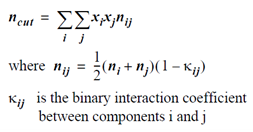
Octane Number Calculations - Technical Information
The Research Octane Number and the Motor Octane Number can be calculated by the SIMSCI method. The SIMSCI method for RON and MON calculations has been published in Twu, C.H. and Coon, J.E., "Predict Octane Numbers Using A Generalized Interaction Method", Hydrocarbon Processing, February 1996, 51-56 and Twu, C.H. and Coon, J.E., "Estimate Octane numbers using an enhanced method" Hydrocarbon Processing, March 1997, 65-68.
The octane number of motor gasoline is one of the most important measures of gasoline quality. It has always been the goal of refiners to predict accurately the octane ratings of blending gasolines. The research and motor octane numbers of a gasoline are measurements of its quality of performance as a fuel. The octane number scale itself is based on the linear blending of isooctane and n-heptane. The octane number of a gasoline is measured on a scale that ranges from that equivalent to isooctane (octane number 100) to that of n-heptane (octane number 0). Octane number is affected by the saturates, aromatics, and olefins contents of gasoline.
Features of the SIMSCI calculation method for RON and MON
The blending correlation blends exactly the octane numbers of isooctane and n-heptane.
The blended octane number is unchanged when blending identical components.
The blending equation describes blending behavior accurately throughout the entire composition range.
The blending correlation works not only for binaries, but also for multi-component systems.
The predicted research and motor octane numbers of a given blend from the correlation is invariant when a component is divided into two or more identical sub-components.
SIMSCI method for RON and MON calculates the octane number of a cut (ncut) by blending the octanes of its components.

The correlation is in a simple form and the binary interaction parameters can be generalized. An universal set of binary interaction parameters has been developed for the interaction correlation. The only input data for the correlation are the RON or MON of each gasoline cut and its olefins, aromatics and saturates contents which are standard laboratory inspection data of gasoline cuts. The component type-oriented interaction method is general and will predict accurately the octane number of gasoline blends.
Notes
The RON and MON calculations by the SIMSCI method require RON or MON, AROMATICS, OLEFINS, and PARAFINS values for each component. Go to the Component Properties window / Refinery Inspection Properties... button to set these values. If these values are not available, the SIMSCI FILL method will be used to predict values as required.
The RON and MON for many pure components have been provided in the SIMSCI databank.
![]()
Related Topics